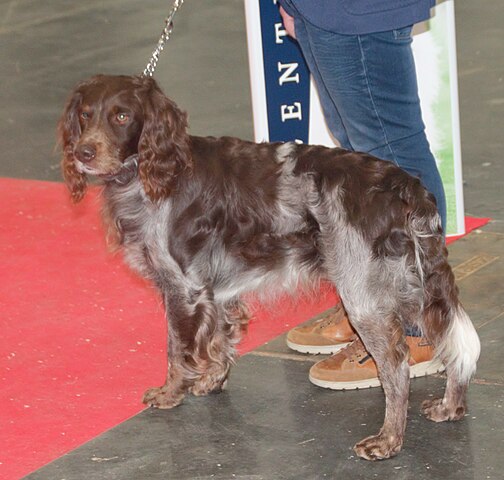The Flat-Coated Retriever is a delightful companion and hunting dog, perfect for the owner who wants a retrieving-obsessed working pet. Like most retriever breeds, the Flat-Coat tends to be very orally fixated and will find things to pick up and carry around – including shoes or other non-dog items. He will need to be trained to play only with his own things, as well as given plenty of fetch-type games to satisfy this impulse.
The Flat-Coat is a dog for an owner who doesn’t mind shedding, as he does tend to shed quite a bit. Regular brushing will be required at couple times a week – and keep in mind that even though their tail might never stop wagging, it still needs a good combing out! Some members of the breed don’t care much about being clean and will gladly roll in mud puddles or even manure. Others have a cleaner sensibility, but most can’t resist a dip in the pool or ocean. Depending on the dog and the owner’s living situation, they usually require a moderate amount of grooming care.
Flat-Coated Retrievers are great at obedience, but also tend to have a sense of humor. They are well-known for behaving perfectly at obedience practices, and then acting as though they’ve never been trained once they get to a competition! This is partially because they stay playful and even puppy-ish well into middle age. It is for this reason that obedience is definitely a necessity. Even though they take a long time to mature, it is much easier to live with a Flat-Coat who has been taught basic rules than one who has not. Those who have never been taught any rules tend to chew things up, become problem barkers and hole-diggers, among exhibiting other problem behaviors. They can be more destructive than other retriever breeds and therefore must be given more mental and physical outlets. For teething puppies and mature adults alike, a Benebone is also an absolute must-have – https://amzn.to/410F5TG
Flat-Coats are, first and foremost, hunting dogs. As such, they are keenly interested in finding game and may try to jump over a short fence in order to go after it. A tall, secure fence is therefore recommended. It has been said that a Flat-Coat will only hunt for someone whom he respects. If he doesn’t value his owner or trainer, than he will hunt for himself. He needs an owner that loves and respects him as well, and provides him with plenty of attention. Flat-Coats left to fend for themselves all day can develop separation anxiety. On the other hand, a well-taken care of Flat-Coat will be supremely loyal and faithful to his owner for his entire life. 
The Flat-Coated Retriever is an active dog who requires plenty of daily exercise. He can adapt to city life but does need more attention to his physical needs than many other breeds. He enjoys his daily outings because he loves spending time with his owners and meeting new people – this is quite a social breed. Flat-Coats are easier to live with in the home as long as they are given these frequent outings. Without enough exercise they tend to jump on guests and small children, and have too much pent-up energy in general. A well-exercised Flat-Coat, on the other hand, is an active but happy member of the family – good with older children and friendly with guests (after a quick bark to alert). This is a very affectionate and cheerful breed who requires an active owner.
Most Flat-Coats get along very well with other pets as they are optimistic and happy in general – lovers and not fighters. They make great companions for other breeds both larger and smaller than they are! This said, an old frail dog that is tiny in size may accidentally be hurt by a bouncing Flat-Coat – so keep this in mind before adding this breed to your household.
Flat-Coated Retrievers are almost always exuberant, and their tails are usually in a perpetual wag! For this reason, they may not be the best choice for someone who keeps lots of delicate items on display. Flat-Coat tails are well-known for clearing coffee tables. The breed is also known for “counter-surfing” AKA stealing food or items atop the stove or countertops. This latter behavior can be managed through training, but their tails cannot be trained to stop wagging. Therefore, they don’t make the best matches for cluttered or small living spaces.
Affiliate Disclaimer
As an Amazon Associate, I earn from qualifying purchases. This means that if you click on an affiliate link on this site and make a purchase, I may earn a small commission at no additional cost to you. Rest assured that I only link to products I have used, or use on a regular basis, and trust enough to recommend them to you!



